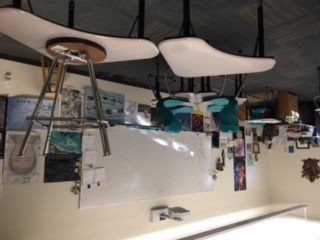Flipped Classrooms

October 21, 2016
Have you wondered why PCS math teachers have been simultaneously flipping their classrooms? Well, to reassure you, it is not being done literally. The Flipped Classrooms method is a system of learning that is a relatively new phenomenon in the PCS math department. The program instructs students to watch a video at home on their lesson, and complete “homework” in class. A new system of quizzes has also been introduced—Standards Quizzes. These quizzes are graded with a binary pass or fail.
Throughout the week of October 3, 2016, I interviewed 10 students and two teachers on their opinions about the Flipped Classrooms learning system. The results of my survey varied. Students’ opinions ranged from saying that the system was “awesome” to saying “I’m not a fan of it in general.” However, the largest commonality between students’ opinions on the Flipped Classrooms system is that students like how they are given less homework. This is in fact one of the ideals that Randy Garrett, head of the math department, hoped the Flipped Classrooms would improve. Students also appreciated that the system encourages them to learn more, due to the fact that a student must completely meet the standard to pass the quiz. One particular Pre-Algebra student, Kyla Rose Parkin, said “I like the videos because you can go back if you need to.” In contrast, Pavlova Orozco Corona, an Algebra 2 student, does not like the system, but appreciates that the method “determines how well you know it, and that is good.”
Another similarity amongst the students’ opinions about the method is correlated to the fact that many feared that the system will not work once the subject gets more difficult. Eric Spencer, a Geometry student enjoys that the method gives him more independence, but Geometry being “simple shapes” makes the system work and “it won’t work with Pre-Calculus”.
I decided to interview another math teacher, Trung Lai. Lai believes that “other teachers have benefitted from the system” and “[he] wishes that students would watch the videos more.” Additionally, Lai asserts that “it gives students kind of a false sense of mastery, but it is good in the sense of needing to practice more.” Lai hopes it “makes people learn better.”
Garrett asserted that the PCS math department’s fundamental reasoning for establishing the Flipped Classrooms was to solve the stress of homework load, and combat the #1 way that students cheat in PCS (transcribing other students’ homework). We can see in our results that many students favor the program because they are given less homework. Garrett also believes that Flipped Classrooms can make students more independent in their learning. This is because students attempt to learn some of the concepts at home, but they are also given aid at school again as the teacher is there to help.
In Garrett’s recent survey about how students liked the Flipped Classrooms, he found that out of 39 students, 23 (58.97%) claim that they are learning a lot, 10 (25.64%) believe that they are learning just as much as if homework was graded, and 6 students (15.38%) think that they are learning less with the new system. Again, since one of Garrett’s initial reasons to start the Flipped Classrooms at PCS was to reduce homework load, he also surveyed students on how much the system has actually made a difference. The results exemplified that 74.26% of students feel that the Flipped Classrooms reduces their homework load. Nevertheless, these varied statistics lean more towards the “pro Flipped Classrooms” side. These results overall assert that the students are equally happy with the Flipped Classrooms as Garrett, meaning that the system will most likely continue as a PCS way of life.

